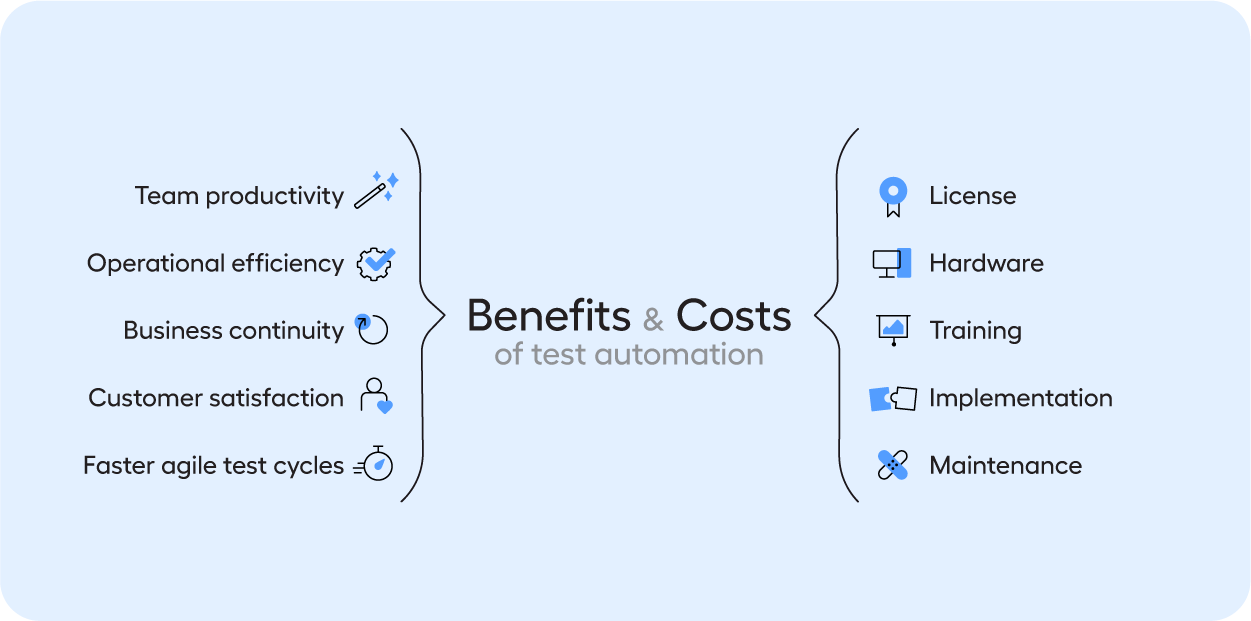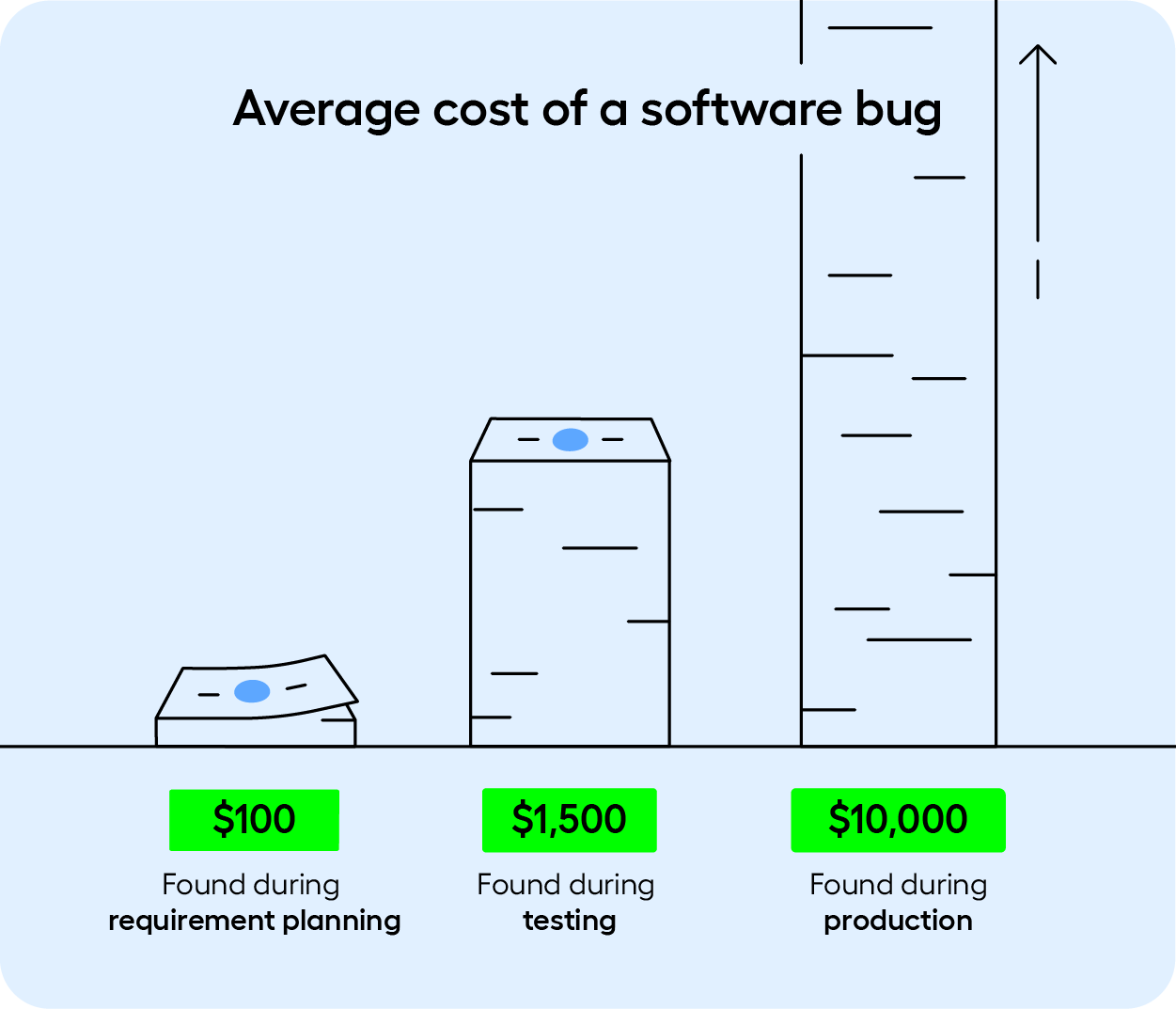How to Build a Business Case for Test Automation
In this blog, we explain the three key benefits of test automation so you can effectively communicate the value of test automation to budget holders.
Surprisingly, software testing still remains a highly manual process, even in software and tech companies.
With the adoption of Agile and DevOps, continuous testing is required throughout the development lifecycle. But at the moment, manual testing is a huge bottleneck. It is not only expensive; it holds back delivery times and innovation.
The good news is that technology leaders are seeing modernization as a strategic imperative and are willing to invest in test automation.
So now is the time to bring forward your business cases. Your business case should show that a test automation solution is a good investment for the business. This means you need to know the key benefits of test automation and know how to communicate those benefits to the business
Benefit 1: Return on investment (ROI)
ROI is always the most pertinent topic for financially-minded decision makers.
During a financial appraisal, stakeholders will want to see a realistic calculation that factors in all short and long-term benefits and costs.
To calculate the ROI of test automation, you need to look at the value gained from automating testing processes compared to the costs.

Test automation provides positive ROI when it saves you time and money by testing more efficiently, but there are also harder-to-quantify benefits, such as customer satisfaction and faster test cycles, which should also be included in your appraisal.
Test automation helps create a tighter feedback loop between the development of code and testing, significantly reducing the time it takes to resolve bugs. So it is not just time spent testing, it’s also time spent resolving, where you reap the benefits of test automation.
Read this article: How to Calculate the ROI of Test Automation: A Practical Guide
Note: Don’t overlook TCO when calculating ROI
Many automation tools in the market are complex, leading to delayed or no positive ROI for companies. Overly technical tools increase the total cost of ownership (TCO), as usage is limited to scarce and costly resources. Technical tools also have longer onboarding and ramp-up periods.
Maintenance demands can also be a drawback for technical tools and contribute to increased TCO. Maintenance diverts resources from doing higher-value tasks like writing code for new features, and hitting pause on innovating is never popular with technology leaders.
Thanks to visual automation platforms, you don’t need any technical expertise to build and maintain test cases anymore. Codeless tools may have a higher upfront cost, but they offer much quicker time to value, better ROI over time, and they are simpler to maintain. The license cost is only ever a fraction of the total organizational costs for a platform.
![[10:32 AM] Chris Schwartz The hidden costs of developer-dependent test automation tools](https://www.leapwork.com/hs-fs/hubfs/hidden-cost-TA-diagram-v1.0.png?width=1250&height=849&name=hidden-cost-TA-diagram-v1.0.png)
To get a faster and more significant return, codeless test automation tools have to be truly code free (beware of the codeless/no-code/low-code label). Some of these solutions may seem appealing initially, but routine maintenance might still involve delving into source code, requiring technical support.
Test automation should be democratized to reach its full potential. Codeless platforms enable manual testers and business users, who are often most familiar with your system, to engage in test automation. Allowing a broader range of users to build flows helps you unlock the benefits of test automation faster and in a more cost-effective way. And that’s a strong narrative for your business case.
Benefit 2: Time to market
A growing number of enterprises have adopted Agile and DevOps methods of software development to keep pace with constantly evolving business requirements. Though they have embraced DevOps, software testing still continues to be one of the most manual-driven processes.
With high dependency on manual testing, QA teams are struggling to keep up with development pace. This is problematic because the longer an organization takes to release new features, the less competitive it is in the market.
Time to market is highly dependent on testing efficiency. In traditional testing processes, testing is carried out as an end-of-development activity. Critical bugs that are found late in the development stage require an immense amount of rework, redesign, and rethinking of strategy. This slows down the time to market.
Enterprises need to incorporate continuous testing to enable DevOps, and to do so, they must utilize automated testing. Automated testing plays a crucial role in enhancing the time to market for software products by embedding it into each phase of the software development cycle. This integration offers several key advantages that streamline development processes, improve quality, and accelerate release timelines.

Automated testing is a cornerstone of CI/CD practices. It allows for the continuous integration of code changes into a shared repository and ensures that these changes do not adversely affect existing functionality. This practice supports frequent code releases, significantly reducing the time to market.
Benefit 3: Risk mitigation
Another key part of building a compelling case for test automation is focusing on the risk element of manual testing.
Manual testing holds its value in exploratory testing where human intuition and creativity are invaluable. However, taking a manual approach to other more routine parts of testing where you need 100% accuracy every time carries a huge risk.
Manual testing exposes the reality that humans are prone to making mistakes. When testers repeatedly perform the same actions, a false sense of confidence can develop. It's like walking down a familiar path with eyes closed – manageable to an extent, but fraught with risks if the environment is complex. Which in software, it invariably is.
Humans make mistakes, and that’s part of being human. But in software testing, errors aren't trivial; they manifest as bugs and issues, leading to reputational risks, financial losses, and legal complications.
In December 2023, it was announced that the Transportation Department was fining Southwest Airlines $140 million for major flight disruptions during the 2022 holiday season and resulted in almost 17,000 significantly delayed or canceled flights.
Fixing common defects after a release is exponentially more costly than catching them earlier on. The cost to fix an error found after product release is then four to five times as much as one uncovered during testing, and up to 100 times more than one identified during the planning phase. In other words, the cost of a bug grows exponentially as the software progresses through the software development life cycle.

Your business case should highlight that manual testing can inadvertently introduce defects that automation could prevent. Test automation, on the other hand, eliminates the variable of human error by performing tests in the exact same manner every time, ensuring consistency and accuracy in the results.
There is a great opportunity with automation to eliminate human errors and more mundane tasks in your organization. Automation takes a weight off the shoulders of QA teams in the development process, and it helps spread a culture of quality and pride in the software across the organization.
Conclusion
If your organization wants to keep pace with digital transformation initiatives, they need to understand the importance of test automation.
Speed-to-market is the name of the game in software. If you can’t quickly test and release enhancements, you lose customers to your competition.
As outlined in this article, the three key benefits of test automation—enhanced ROI, reduced time to market, and reduced risk—form a strong foundation for advocating its adoption.
Focusing on these areas in your business case will highlight how test automation is a long-term investment that saves money and time while reducing business risk.


